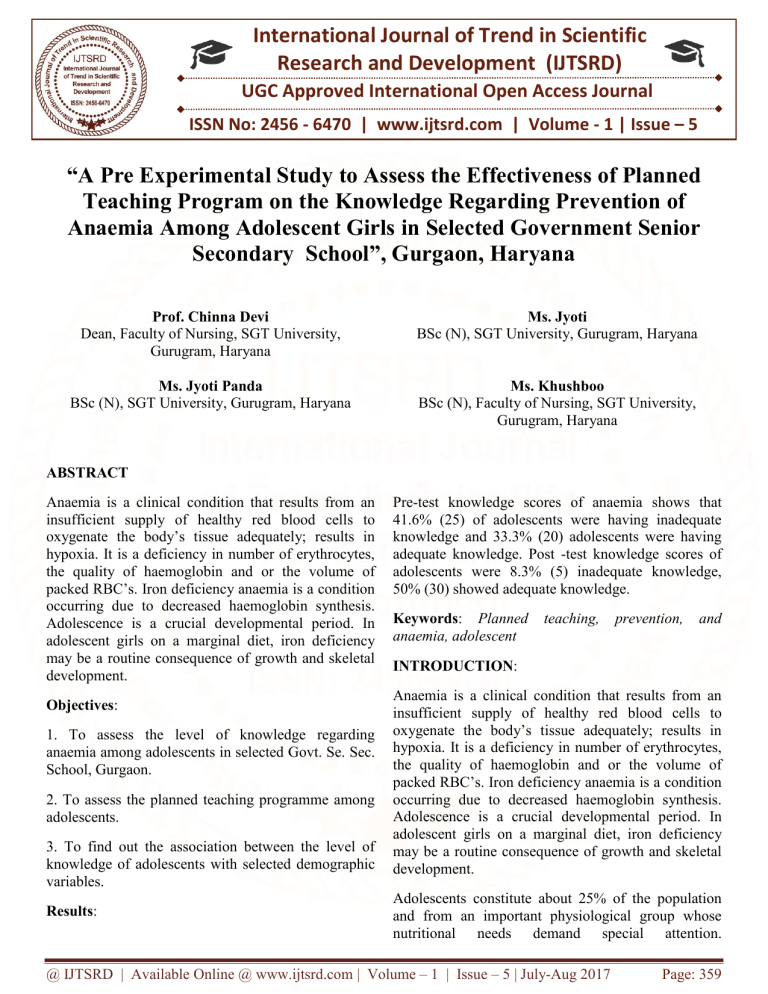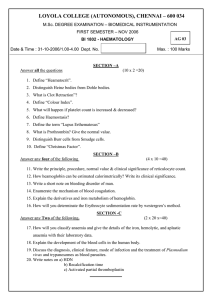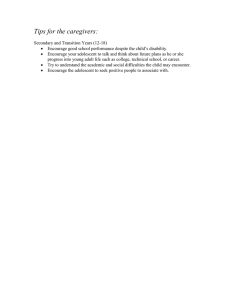
International Journal of Trend in Scientific
Research and Development (IJTSRD)
UGC Approved International Open Access Journal
ISSN No: 2456 - 6470 | www.ijtsrd.com | Volume - 1 | Issue – 5
“A Pre Experimental Study to Assess the Effectiveness of Planned
Teaching Program on the Knowledge Regarding Prevention of
Anaemia Among Adolescent Girls in Selected Government Senior
Secondary School”, Gurgaon, Haryana
Prof. Chinna Devi
Dean, Faculty of Nursing, SGT University,
Gurugram, Haryana
Ms. Jyoti
BSc (N), SGT University, Gurugram, Haryana
Ms. Jyoti Panda
BSc (N), SGT University, Gurugram, Haryana
Ms. Khushboo
BSc (N), Faculty of Nursing, SGT University,
Gurugram, Haryana
ABSTRACT
Anaemia is a clinical condition that results from an
insufficient supply of healthy red blood cells to
oxygenate the body’s tissue adequately; results in
hypoxia. It is a deficiency in number of erythrocytes,
the quality of haemoglobin and or the volume of
packed RBC’s. Iron deficiency anaemia is a condition
occurring due to decreased haemoglobin synthesis.
Adolescence is a crucial developmental period. In
adolescent girls on a marginal diet, iron deficiency
may be a routine consequence of growth and skeletal
development.
Objectives:
1. To assess the level of knowledge regarding
anaemia among adolescents in selected Govt. Se. Sec.
School, Gurgaon.
2. To assess the planned teaching programme among
adolescents.
3. To find out the association between the level of
knowledge of adolescents with selected demographic
variables.
Results:
Pre-test knowledge scores of anaemia shows that
41.6% (25) of adolescents were having inadequate
knowledge and 33.3% (20) adolescents were having
adequate knowledge. Post -test knowledge scores of
adolescents were 8.3% (5) inadequate knowledge,
50% (30) showed adequate knowledge.
Keywords: Planned
anaemia, adolescent
teaching,
prevention,
and
INTRODUCTION:
Anaemia is a clinical condition that results from an
insufficient supply of healthy red blood cells to
oxygenate the body’s tissue adequately; results in
hypoxia. It is a deficiency in number of erythrocytes,
the quality of haemoglobin and or the volume of
packed RBC’s. Iron deficiency anaemia is a condition
occurring due to decreased haemoglobin synthesis.
Adolescence is a crucial developmental period. In
adolescent girls on a marginal diet, iron deficiency
may be a routine consequence of growth and skeletal
development.
Adolescents constitute about 25% of the population
and from an important physiological group whose
nutritional needs demand special attention.
@ IJTSRD | Available Online @ www.ijtsrd.com | Volume – 1 | Issue – 5 | July-Aug 2017
Page: 359
International Journal of Trend in Scientific Research and Development (IJTSRD) ISSN: 2456-6470
Adolescence is a period of rapid growth, weight gain
and blood volume expansion. The overall iron
requirement of the body increases in this period. At
the same time the risk of iron deficiency anaemia
among boys and girls appears to be more due to
growth spurt, and in girls it remains high during their
reproductive life.
In India, anaemia affects an estimated 50% of the
population. Numerous studies shown that the
prevalence of anaemia among adolescent girls is high.
India has one of the fastest growing youth populations
in the world, with an estimated 190 million
adolescents. Girls below nineteen years of age
comprise one quarter of India’s growing population.
NEED OF THE STUDY:
Adolescence has been defined by WHO as the period
of life spanning between the age of 10- 19 years. This
is the formative period of life when the maximum
amount of physical, psychological and behavioural
changes take place. This is a vulnerable period of
human life cycle for the development of nutritional
anaemia. Girls are more likely to be victims due to
various reasons. In a family with limited resources,
the female child is more likely to be neglected. The
girls are more deprived of good food and education
and are utilized as an extra hand to carry out the
household chores. An added burden of menstrual loss
precipitates the crises too often.
As rapid development take place in this period, they
need more nutritious and healthy diet. Iron is needed
for the expansion of blood volume, muscle mass and
also gain 20% of adult weight and 30% of adult’s
height during adolescence period.
Anaemia is one of the most common diseases in
adolescence period, hence it offers to acquire
knowledge about optimal nutrition that could prevent
or delay adult onset, and diet related illness in later
stages of life. Anaemia reduces physical activity and
cognitive function, learning and scholastic
performance in school entering adolescents. In this
modernized era, School going adolescents are
skipping meals to make them thin and slender and
many of them tend to have fast food or junk food.
This also leads to deficiency of healthy rich diet and
in turn contributing to anaemia in adolescents.
A study conducted by the International centre for
research on women mentioned that adolescent
anaemia in both males and females include: Nepal
42%, India 52%, and Cameroon 32% respectively.
A cross sectional study was carried out in Dhaka
among 65 adolescents to investigate the dietary
pattern. The results showed that there was a deficit of
437 kcal/day in energy and prevalence of anaemia
was 23%.73.8% of the participants were not aware of
the source of iron rich foods. The result concluded
that the overall nutritional status of the urban
adolescent college girls in Bangladesh as a whole was
poor.
The above findings showed that the adolescent girls
were having inadequate knowledge regarding anaemia
and its management. Hence the investigator felt that
there is a need to conduct a study which can
significantly increase the knowledge of adolescent
girls.
PROBLEM STATEMENT
A Pre Experimental Study to Assess the Effectiveness
of Planned Teaching Programme on the Knowledge
of Anaemia among Adolescent girls in selected
Government Senior Secondary Schools, Gurgaon,
Haryana.
OBJECTIVES
1. To assess the level of knowledge regarding
anaemia among adolescent girls in selected
Government senior secondary school, Gurgaon.
2. To assess the planned teaching programme among
adolescent girls in selected government senior
secondary schools, Gurgaon.
3. To find the association between the level of
knowledge of adolescent girls with selected
demographic variables.
OPERATIONAL DEFINITIONS
Assess: It refers to the statistical estimation of the
knowledge regarding prevention of anaemia among
adolescent girls by using structured knowledge
questionnaire.
Effectiveness: It refers to the gain in knowledge as
determined by the significant difference in pre-test
and post-test knowledge as elicited throughstructured
knowledge questionnaire.
Knowledge: It refers to the correct response of
adolescent girls to the structured knowledge
questionnaire on anaemia prevention.
@ IJTSRD | Available Online @ www.ijtsrd.com | Volume – 1 | Issue – 5 | July-Aug 2017
Page: 360
International Journal of Trend in Scientific Research and Development (IJTSRD) ISSN: 2456-6470
Adolescent girls: The girls between the age group of
16-18 years.
12gm/dl) and 40% of them were eating two or fewer
meals daily.
Planned teaching programme: It is systematically
planned and organized programme and validated by
subject experts.
SubhraSrimanietal (2008) conducted a comparative
study on prevalence of anaemia among rural and
urban school going 96 adolescent girls between the
age groups 16- 18 years. The study concluded that
prevalence of anaemia is high i.e. 81% in rural than
Urban with 31%.
HYPOTHESIS
Ң: There is a significant difference in the pre-test and
post-test knowledge scores of adolescent girls
regarding anaemia.
H₂: There is a significant association between the
post-test knowledge score of adolescent girls with
demographic variables.
REVIEW OF THE LITERATURE
Kumar etal(2006) conducted a study on influence of
family’s vegetable cultivation on prevalence of
anaemia among
80 rural adolescent girls in
Allahabad, UP. Among 80 adolescents forty from
vegetable grower and forty from non-vegetable
grower family’s. The findings were prevalence of
anaemia is less in vegetable grower family
adolescents P level is P<0.005.
Senetal (2006) conducted a study on deleterious
functional impact of anaemia on young low income
adolescent school girls and was conducted in four
Vadodara Municipal high schools and sample size
was 350. The study concluded that prevalence of
anaemia was high i.e. 67% and also found that the
non-anaemic girls scored higher than their anaemic
counterparts in cognitive tests.
Diwaker (2008) conducted a study on 6,948 rural
adolescent girls, India and the findings were 69.40%
of girls were anaemic.
Joy P. Mariamma (2011) conducted a quasiexperimental study to assess the effectiveness of selfinstructional module on knowledge regarding anaemia
among 60 adolescent girls in selected pre university
colleges of Mangalore, Karnataka, India. And the
result showed significantly increased the knowledge
in prevention of anaemia.
Balci YI etal (2012) carried out a study to determine
the prevalence and risk factors of anaemia among
1120 adolescent boys and girls aged between 12-16
years in DENIZLI, TURKEY. The results were 59%
were diagnosed as IDA, 41% were diagnosed as
combined iron deficiency and vitamin B12 deficiency
anaemia.
Kokere B.A etal (2013) conducted a study to
determine the prevalence of anaemia in 310 school
children between the age group of 5-11 years (boys
138 and 172 girls) from three municipal schools,
Abidjan. The results were 33.3% in males and 29.1%
in females respectively.
METHODOLOGY
Research
Approach
Approach:
Experimental
Research
Research Design: Pre-experimental research with one
group pre-test post-test design.
Gupta etal (2007) conducted a study on prevalence of
anaemia in 160 adolescent girls between the age
group of 11-13 years and 100 between 14-17 years
studying in government educational institutions of
Kurukshetra district, Haryana. The study concluded
that maximum i.e 58.08% of them were suffering
from moderate followed by mild anaemia 33.85%
respectively.
Sample and Sampling Technique:
Pande (2008) conducted study on reducing iron
deficiency anaemia and changing dietary behaviours
among 1000 adolescent girls between the age groups
of 10-19 years in Maharashtra, India. The study
revealed that 58% of the samples were anaemic (Hb<
Sampling technique: Non probability convenient
sampling technique
Setting of the study government senior secondary
girls school, GURGAON
Population: Target population were Adolescent girls
studying government senior secondary schools,
Gurgaon
Sample size: 60
@ IJTSRD | Available Online @ www.ijtsrd.com | Volume – 1 | Issue – 5 | July-Aug 2017
Page: 361
International Journal of Trend in Scientific Research and Development (IJTSRD) ISSN: 2456-6470
Inclusion criteria: willing to participate, availability
of the samples
Exclusion criteria: not willing to participate, nonavailability of the samples
Selection of
questionnaire.
the
Tool:
8) Huang SC, yang YJ, Cheng CN, Chen JS, Jl of
PediatricHemato Oncology.2010 May;32 (4); 2825
Structured knowledge
Analysis of the data:
Pre-test knowledge scores of anaemia shows that
41.6% (25) of adolescents were having inadequate
knowledge and 33.3% (20) adolescents were having
adequate knowledge. Post -test knowledge scores of
adolescents were 8.3% ( 5) inadequate knowledge,
50%( 30) showed adequate knowledge.
Summary:
Anaemia is a condition in which haemoglobin level is
lower than normal. Typically it results when the
intake of dietary iron is inadequate for haemoglobin
synthesis. Adolescent period is a crucial
developmental period. Adolescent girls are caught in
menstrual cycles, early marriages, repeated
pregnancies and poverty. Hence it is important to
educate the adolescent girls regarding prevention of
anaemia and its related complications.
REFERENCES:
1) KabirY,shahjalal HM, Salesh F, Obaid W , Jl of
Pak Med Assoc.2010 Aug:60(8): 633-8
2) Dongre A R, Deshmukh P R, Garg BS Food Nutr
Bull, 2011 Dec;32 (4):315-23
3) Charles CV, Summerlee AJ, Dewey Asia PAC J
ClinNutr, 2012:21(2):171-81
4) Kahlon N, Gandhi A, Mondal S, Narayan S
Indian Jl of Physio Pharmacology. 2011 Janmar;55 (1): 53-9
5) Goudarzi, K ,Mehrabi M R, Pak Jl of Biomedical
Sciences. 2008 May 15; 11 (10):1398-400
6) Sen A, Kanani s, Jl of Indian Pediatrics. 2006
March;43 (3):219-26
7) Stag J, Bayerl CT Jl American Diet Association.
2010 May; 110 (5):791-99
@ IJTSRD | Available Online @ www.ijtsrd.com | Volume – 1 | Issue – 5 | July-Aug 2017
Page: 362





